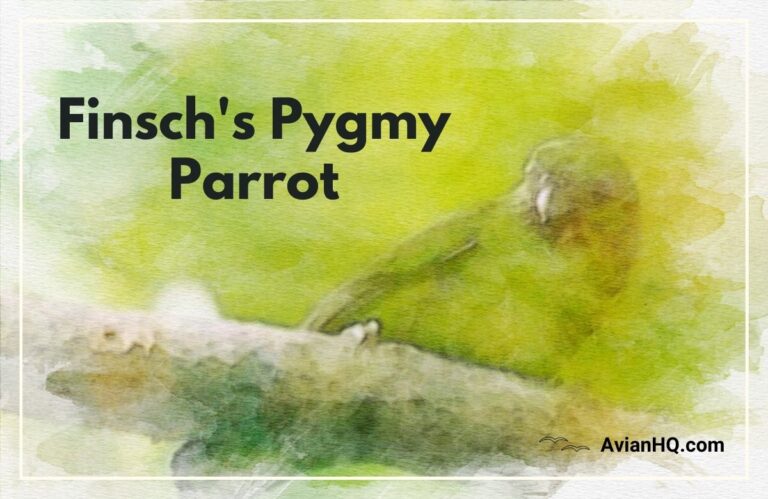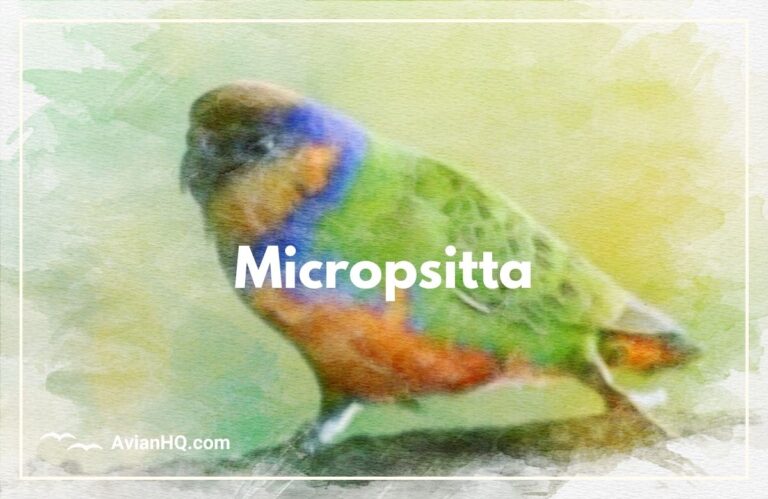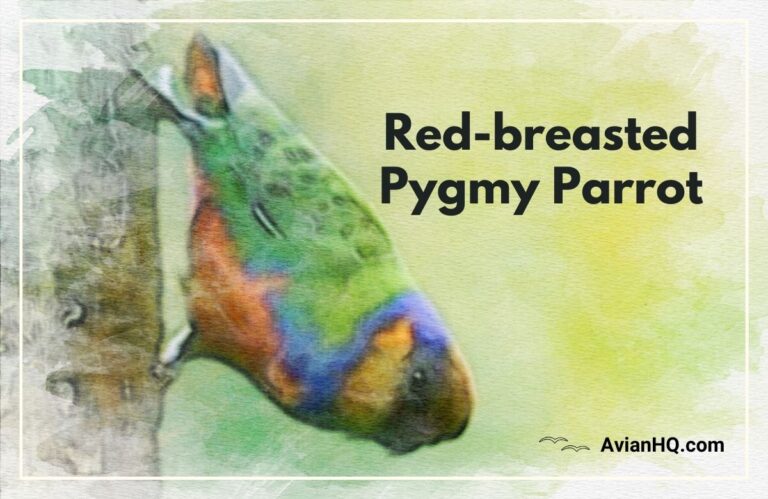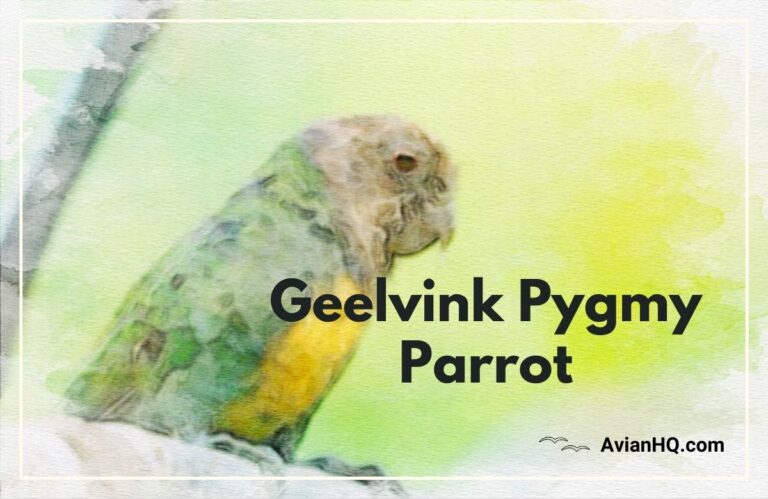Buff-faced Pygmy Parrot (Micropsitta pusio)
Have you ever seen a parrot the size of a hummingbird? As incredible as it sounds, the buff-faced pygmy parrot is a real bird – and it just might be the world’s smallest parrot species.
Measuring only around 3 inches long and weighing less than half an ounce, this tiny tropical parrot is truly miniature compared to it’s larger, more colorful cousins. But don’t let it’s tiny stature fool you – this little parrot has just as much personality as it’s bigger relatives.
The buff-faced pygmy parrot is native to the rainforests of New Guinea and some nearby islands. It lives high up in the forest canopy, flitting through the trees and across branches. Despite it’s name, the parrot’s main color is green, with golden-yellow underparts and the distinctive buff-brown face that gives it it’s name.
While not commonly seen in captivity, the wild populations of these petite parrots seem to be doing well in their tropical island homes. Their specialized diet of lichens and fungi makes them difficult to maintain in aviculture.
If you ever find yourself wandering the rainforests of New Guinea, keep an eye out overhead. You just might spot one of these tiny, colorful birds as it zips past. But don’t blink – at less than 9 centimeters long, it can be easy to miss!
The buff-faced pygmy parrot proves big things really can come in small packages. Read on to learn more about this pint-sized parrot.
History and Taxonomy
The buff-faced pygmy parrot was first described scientifically in 1866 by the English naturalist Philip Lutley Sclater. He gave it the scientific name of Micropsitta pusio.
The genus name Micropsitta comes from the Greek words mikros meaning “small” and psittakos meaning “parrot”, referring to the bird’s tiny size. The species name pusio is Latin for “little boy”.
Four subspecies of the buff-faced pygmy parrot have been recognized:
- M. p. pusio – The nominate subspecies found in the Bismarck Archipelago and southeastern New Guinea
- M. p. harterti – Found on Fergusson Island with blue-tinged throats and less distinct markings
- M. p. stresemanni – Slightly larger birds on Misima and Tagula Islands with more yellowish underparts
- M. p. beccarii – Darker overall plumage in western New Guinea
The validity of these subspecies has been questioned by some ornithologists. More research is needed to determine if they truly represent distinct geographic varieties.
Physical Appearance
The buff-faced pygmy parrot is tiny, measuring approximately 8.4 cm (3.3 inches) in length. It weighs just 10-15 grams (0.35-0.53 ounces), making it one of the smallest parrot species in the world.
Its plumage is predominantly green above with yellowish-green underparts. The most distinctive feature is the adult’s buff-brown face and forehead. It has a dark blue patch on the crown and back of the head. Females have slightly duller facial markings.
The eyes are dark brown, the bill is gray, and the legs are gray with bluish-pink tints. Juveniles have an all-green head lacking the blue crown patch. The subspecies vary somewhat in overall plumage darkness and color tones.
Despite it’s diminutive stature, the buff-faced pygmy parrot remains an active, acrobatic flyer. it’s short tail and rounded wings provide excellent maneuverability through dense forest habitat.
Habitat and Distribution
The buff-faced pygmy parrot is endemic to the island of New Guinea and some nearby islands including the Bismarck Archipelago. it’s range extends across southern and eastern New Guinea.
This species inhabits lowland rainforests up to elevations of around 900 meters (2,950 feet). It is found in primary forest as well as secondary growth and hill forests.
On the island of New Guinea, it occurs from Geelvink Bay in the west to the Papuan Peninsula in the southeast. It is also present on islands such as Misima and Fergusson Island in the Louisiade Archipelago off the coast of New Guinea.
Though widespread across it’s native range, the buff-faced pygmy parrot has a patchy distribution and is locally common in some areas but rare in others. it’s natural habitat is declining due to deforestation in parts of New Guinea.
Diet and Feeding
The diet of the buff-faced pygmy parrot consists mainly of lichens, fungi, seeds, fruits, and some insects.
This unusual diet sets it apart from many other parrot species. It relies heavily on lichens and fungi that grow on the bark and branches of trees in it’s tropical forest habitat. This may help explain why it does not adapt well to captivity or captive diets.
The buff-faced pygmy parrot uses it’s slim, pointed bill to pick small lichens and fungi off of trees. It also feeds on tiny seeds and soft fruits. To a lesser degree, it eats insects like ants and caterpillars.
Foraging occurs mostly high in the forest canopy. The birds move quickly through the trees in small flocks, actively searching trunks, branches, and epiphytes for food. Their feeding behaviors are not well-studied in the wild.
Breeding and Reproduction
Relatively little is known about the breeding habits of the buff-faced pygmy parrot. They nest in tree cavities, using old woodpecker holes or natural hollows. They have also been observed nesting in arboreal termite mounds.
The typical clutch size is around 3 eggs. The eggs are small, approximately 0.6 x 0.5 inches (16.5 x 13.5 mm) and rounded in shape.
The breeding season is from September through May. Both parents help incubate the eggs and care for the young. Incubation length and time to fledging are unknown.
More research is needed on the nesting requirements, parental behaviors, and early growth of buff-faced pygmy parrot chicks. Their reproduction in captivity has so far been unsuccessful, limiting observations.
Behavior and Ecology
The buff-faced pygmy parrot exhibits social behaviors typical of many parrot species. They are usually seen in small flocks of up to 6 birds. Larger gatherings of up to 30 individuals may form where food sources are abundant.
This species is quick and agile as it forages through the forest canopy. it’s flight is described as being fast and direct.
Roosting occurs communally, with flock members gathering together at the end of the day in a chosen tree cavity or dense vegetation.
Interactions with other bird species appear to be peaceful. Mixed foraging flocks may form, allowing the pygmy parrot to associate with other small rainforest birds. However, it’s specialized diet reduces competition with most species.
Predators of the buff-faced pygmy parrot likely include tree-dwelling snakes and raptors such as hawks and falcons. it’s excellent maneuverability helps protect it from predation. Mortality rates and lifespan are unknown for wild populations.
Conservation Status
The buff-faced pygmy parrot is evaluated as Least Concern on the IUCN Red List of Threatened Species. Although population numbers are unknown, the species is described as generally common within it’s range.
Its total population is presumed to be stable and not nearing the thresholds for a threatened category. However, some localized declines have occurred due to habitat loss.
This parrot is listed on CITES Appendix II, regulating international trade to avoid negatively impacting wild populations. Major threats include deforestation across parts of New Guinea, primarily from logging and agricultural expansion.
There are few targeted conservation efforts for the buff-faced pygmy parrot. Protected areas exist across portions of it’s range, but improved habitat protection is needed in certain regions. Further monitoring of wild populations would help confirm it’s stable status.
Cultural Significance
The buff-faced pygmy parrot does not appear to have major significance in the mythology or cultural practices of New Guinea’s indigenous peoples.
As a tiny, inconspicuous bird high in the rainforest canopy, it keeps a low profile compared to New Guinea’s more visible and vocal parrot species. Documentation is limited regarding traditional knowledge or uses of this species.
Across New Guinea, tribal customs incorporate bright parrot feathers into ceremonial costumes and headdresses. However, the small size and green coloration of the pygmy parrot make it’s feathers less desirable for ornamental use.
More research on indigenous perspectives would be needed to fully understand if this minute parrot holds any cultural symbolism or importance for traditional forest-dwelling communities. it’s elusive nature may limit indigenous interactions and associations.
Conclusion
The buff-faced pygmy parrot is an incredibly small, unique parrot endemic to New Guinea and it’s surrounding islands. Though diminutive in size, it shares many typical parrot behaviors and traits.
With it’s vivid green plumage accented by a distinct buff-colored face, this pint-sized parrot is adapted to life high in the rainforest canopy. It fills an important ecological niche, dispersing lichens, fungi, and small seeds across it’s habitat.
While not threatened, continued habitat conservation is needed across it’s range. There are still many mysteries surrounding the life history and biology of the buff-faced pygmy parrot. Further field studies of this species will reveal more about it’s niche in New Guinea’s complex forest ecosystems.
So if you are ever exploring the tropical forests of New Guinea, keep an eye out overhead for a flash of green and buff. It just may be one of the world’s smallest parrots, the amazing buff-faced pygmy parrot!







